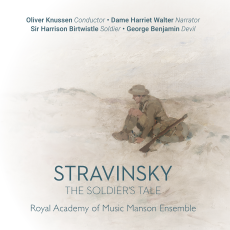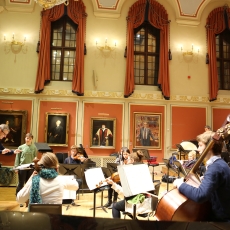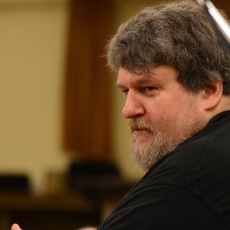Royal Academy of Music Manson Ensemble & Oliver Knussen - Stravinsky: The Soldier's Tale - The Art Music Lounge
Stravinsky’s L’Histoire du Soldat was specified by the composer to be narrated in the vernacular of each country’s performers, unlike his operas which were to be sung in Russian (Le Rossignol), Latin (Oedipus Rex) and English (The Rake’s Progress). He stuck to his guns on this, although he allowed the narration in Oedipus Rex to be spoken in the vernacular.
Thus most recordings of The Soldier’s Tale are in English, not only because they are recorded in English-speaking countries but also because English is now the dominant world language for science and the arts, having replaced French which in turn replaced Latin. The recording I had for several decades was made way back in 1988 and featured Ian McKellen as the narrator, Sting as the Soldier and Vanessa Redgrave as the Devil, conducted by Kent Nagano (a first-rate Stravinsky interpreter). That being said, I had to pull it off my shelf and play it in order to make a comparison as I hadn’t listened to it in at least a decade.
There are as many likenesses as differences here. Both recordings have marvelously clear, crisp sonics, always a prerequisite for Stravinsky’s music. Both are conducted with good rhythmic spring and textural clarity, also necessary for this music. I liked the fact that Knussen’s performance was consistently a shade quicker in tempo; this helped not only the music but the narration, which in the Nagano recording sometimes felt slack despite the consistently over-the-top delivery of McKellen and Sting. Of course, a little over-the-top certainly works here, and Dame Harriet Walter—a terrific actress—does not get cheated in narrating this tale. One of the more interesting aspects of this performance was that the narrator assumes some of the lines of the Soldier, i.e., the long passage near the end of Scene 1, “Eh? Eh? The dirty cheat,” ending with the words “What am I going to do now?” as well as in Scene 2, “Come along, ladies!” Yes, it works because Walter is so good, but I have no idea why portions of it were switched around. (David Gutman, in the Gramophone, suggests that the McKellen-Sting recording used an alternate edition “less faithful to the studied anti-realism of Ramuz’s original concept.”)
By and large, Harrison Birtwhistle as the Soldier and George Benjamin as the Devil are more laid back in their delivery, particularly the former. It works because Birtwhistle sounds natural, like a normal person talking and not an “ACTOR,” if you know what I mean. But this does point out the differences in the performances. And if and when things seem to be getting a bit too quiet, along comes Walter and/or Knussen to kick up the voltage a bit and get us back on track. The bottom line is that both are superb performances, albeit slightly different, but this one has the extra bonus of additional music included by Stravinsky as well as by Birtwhistle and Peter Maxwell Davies written in honor of the Russian composer. The Birtwhistle pieces were composed specifically for this CD release and, although I don’t consider him a major composer, he is certainly a skilled craftsman whose work here dovetails nicely with the Maxwell Davies, which are not among his most serious pieces.
What I find so fascinating about Stravinsky is that, even in the very short works presented here—Fanfare for a New Theatre is less than a minute long, and the other two less than than a minute and a half—was that he always seemed to be thinking in terms of maximum impact in the most compact and concise timeframe. In other words, he didn’t waste time in his compositions, and I think that, as much as his rhythmic and harmonic innovations, was what put him head and shoulders above most of his peers.
In short, this is a terrific release, so good, in fact, that I chose to replace the Nagano-Sting recording with it in my collection.


